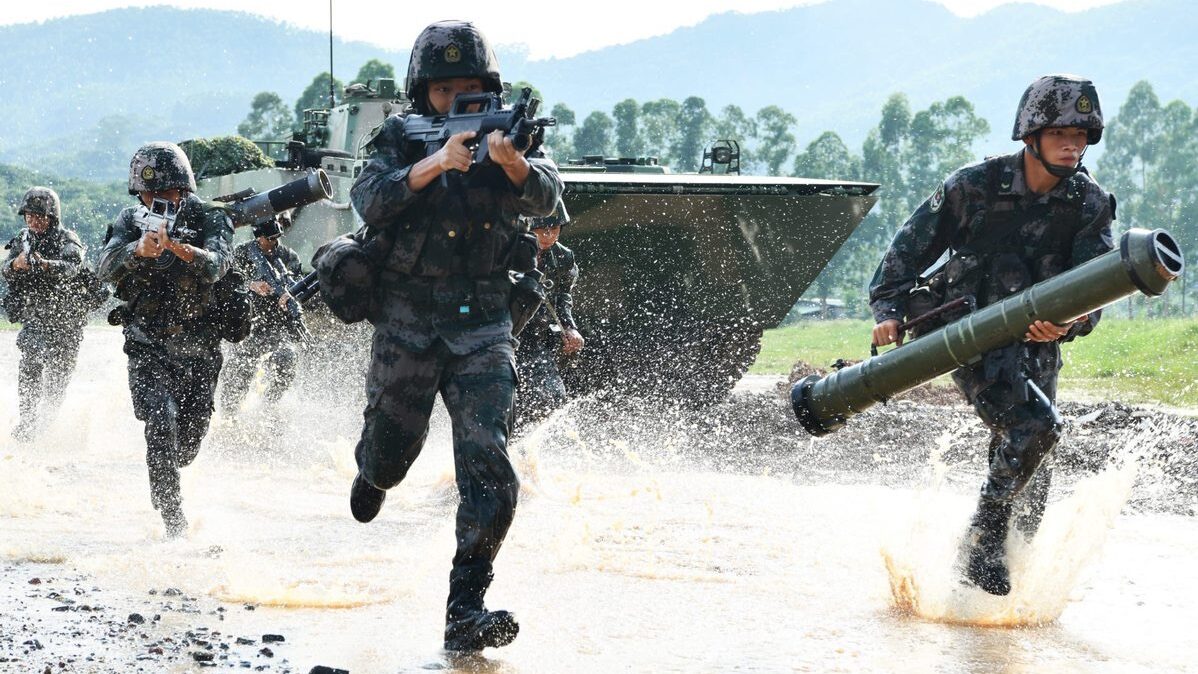Soldiers of the 74th Army Group of the People’s Liberation Army take part in a battle drill in a coastal area of Guangdong province in June 2020 [Credit Xinhua]
SYDNEY — As leaders from the “Quad” gathered this weekend to toast the Indo-Pacific partnership, a new report is sounding alarms that the US is no longer the dominant military power in Asia.
The new report from the Lowy Institute here says that the People’s Republic of China “has closed more than a quarter of the lead that the United States held in this measure in 2018. For the first time, experts surveyed for the Asia Power Index judged that China is better able to deploy rapidly and for a sustained period in the event of an interstate conflict in Asia.”
While undoubtedly concerning, the Institute’s report also notes there are reasons for cautious optimism, in that Beijing’s overall power in the region is beginning to “plateau” as its population begins to fall and its economy falters under the weight of enormous debt and its reeling real estate sector. The Lowy Institute produces the “Asia Power Index” each year.
“China’s power is neither surging nor collapsing. It is plateauing at a level below that of the United States, but still well above any Asian competitors,” the new report by Susannah Patton, Jack Sato and Herve Lemahieu says. “Flatlining economic capability, driven by slower economic growth and longer-term structural challenges, means that China’s economic clout, while still commanding, is no longer growing.”
In light of constant Chinese claims that the United States has no business operating in the western Pacific and is a fading power, the Lowy Institute report’s authors find that “US staying power and dynamism in Asia, this year as in years prior, has confounded the pessimists. The United States leads China on six out of eight measures in the Asia Power Index.”
US President Joe Biden made clear in an unguarded moment during this weekend’s Quad meetings in Delaware that China and the United States are competing in the region.
“China continues to behave aggressively, testing us all across the region, and it’s true in the South China Sea, the East China Sea, South China, South Asia and the Taiwan Straits,” Biden was overheard in what were supposed to be private remarks but were caught on a live mic.
Perhaps the biggest surprise in the study is the rapid decline of Russia’s estimated influence in the Indo-Pacific due to its invasion of Ukraine.
“Russia, the ‘no limits’ partner to China, was overtaken by Australia in fifth place in the Asia Power Index rankings. For a second consecutive year, it was among the three countries with the worst declines in comprehensive power in Asia,” according to the report. “Moscow has paid a heavy price for its disastrous invasion of Ukraine, which continues to sap focus and resources. President Vladimir Putin’s visit to three countries in Asia in 2024 looked more like an effort to shore up dwindling influence than a sign of continued relevance to the region.”
By contrast, Japan demonstrated an impressive military and diplomatic rise, in part a reflection of the closer relations forged between the United States and other Pacific allies in the face of China’s blatant bullying of the Philippines and dangerous and unprofessional maneuvers involving Australian, Dutch, American and other air and sea assets.
“Japan’s transformation from an economic and cultural powerhouse to one based also in defense and security engagement with its neighbors is among the key trends identified by the 2024 Asia Power Index,” the report finds. “Tokyo has stepped up as a regional security provider — a development exemplified by its signing of a Reciprocal Access Agreement with Manila.” Japan’s increasingly close relations with Australia and South Korea must also play a role in this.
India, ranked third below China, has overtaken Japan in terms of overall regional power, but the report notes “Delhi still has limited ability to project power and influence east of the Malacca Strait. However, the fact that its influence remains well below the level promised by its resources suggests it still has ample potential for further growth as a major power.”
Adds the report’s authors, “India’s great strength in Asia is the resources it brings from its huge population, landmass, and economy — already the world’s third-largest in terms of purchasing power parity (PPP).”
Among the other secondary powers in the Indo-Pacific, Indonesia’s power “has grown more than any other since the inception of the Asia Power Index, by 2.9 points in 2024 alone, marking an 11 per cent increase on its 2018 score. The Philippines has overtaken an embattled nuclear power, Pakistan, to reach fifteenth place in the Asia Power Index. Manila’s strategy of seeking closer ties with the United States, as well as a broader range of US-aligned partners outside ASEAN, resulted in an increase in its comprehensive power, driven in particular by its strengthened Diplomatic Influence.”











